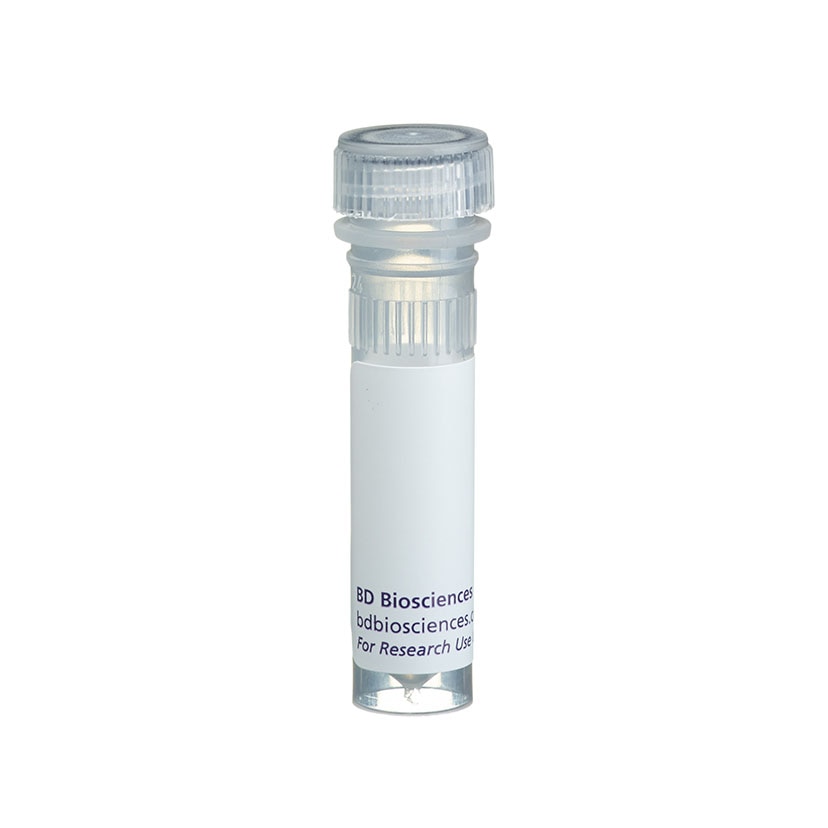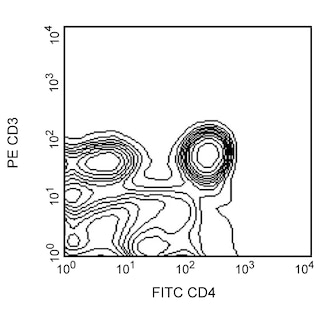Old Browser
Looks like you're visiting us from {countryName}.
Would you like to stay on the current country site or be switched to your country?




Flow cytometric analysis of CD178 expression on activated rat T lymphocytes. T lymphocytes from LEW spleen (rat T Cell Enrichment Column, R&D Systems, Minneapolis, MN) were cultured for 7 hours in the presence of plate-bound Purified NA/LE Mouse Anti-Rat αβ T-Cell Receptor R73 (Cat. No. 554910, top panels) and Purified NA/LE Mouse Anti-Rat CD28 (Cat. No. 554992, top panels) or on uncoated plates (bottom panels). They were simultaneously stained with FITC Mouse Anti-Rat CD4 (Cat. No. 554837, all panels) and Purified NA/LE Hamster Anti-Mouse and Rat CD178 (middle panels) or PE Mouse Anti-Rat CD25 (Cat. No. 554866, right panels) to demonstrate activiation, followed by biotinylated goat anti-Armenian hamster IgG (Jackson Immunoresearch, West Grove, PA), then Streptavidin-PE (Cat. No. 554061, top and bottom, left and middle panels). Flow cytometry was performed on a BD FACSCalibur™ flow cytometry system.


BD Pharmingen™ Purified NA/LE Hamster Anti-Mouse and Rat CD178

Regulatory Status Legend
Any use of products other than the permitted use without the express written authorization of Becton, Dickinson and Company is strictly prohibited.
Preparation And Storage
Recommended Assay Procedures
We have found that enriched splenic T cells are induced to express Fas Ligand by 6 - 8-hour culture with plate-bound Purified NA/LE Mouse Anti-Rat αβ T-Cell Receptor (Cat. No. 554910) and Purified NA/LE Mouse Anti-Rat CD28 (Cat. No. 554992). Because Fas Ligand is expressed at low density on activated cells, we recommend the use of a biotinylated second-step antibody, such as polyclonal goat anti-hamster IgG, with a "bright" third-step reagent, such as Streptavidin-PE (Cat. No. 554061). Other reported applications include blocking of the cytotoxic activities of mFasL-transfected L5178Y T lymphoma, rFasL-transfected COS cells, and rFasL-transfected L5178Y cells.
Product Notices
- Since applications vary, each investigator should titrate the reagent to obtain optimal results.
- Although hamster immunoglobulin isotypes have not been well defined, BD Biosciences Pharmingen has grouped Armenian and Syrian hamster IgG monoclonal antibodies according to their reactivity with a panel of mouse anti-hamster IgG mAbs. A table of the hamster IgG groups, Reactivity of Mouse Anti-Hamster Ig mAbs, may be viewed at http://www.bdbiosciences.com/documents/hamster_chart_11x17.pdf.
- Please refer to http://regdocs.bd.com to access safety data sheets (SDS).
- Species cross-reactivity detected in product development may not have been confirmed on every format and/or application.
- Please refer to www.bdbiosciences.com/us/s/resources for technical protocols.
Companion Products



.png?imwidth=320)
.png?imwidth=320)
The MFL4 monoclonal antibody, generated against mouse CD178 (Fas Ligand, CD95 Ligand), cross-reacts with the rat Fas Ligand antigen. MFL4 mAb detects rat Fas Ligand expressed by transfected cells, but not the parental cell line. In addition, the epitope detected by MFL4 can be induced on activated rat splenic T lymphocytes. The MFL4 mAb has been reported to inhibit killing of mouse lymphoma line A20.2J by rat FasL-transfected cells. The tissue distribution of mouse Fas Ligand has been well characterized. It is expressed at the mRNA and protein levels in a variety of tissues and cell types, including spleen, bone marrow, testis, uterus, eye, and activated lymphocytes. The expression of Fas Ligand in the rat has been detected in liver Kupffer cells, T cells in the central nervous system, spleen, and corpus luteum. MFL4 antibody reacts with the mouse Fas Ligand protein in a pattern similar to that of MFL3 antibody. Fas Ligand is a type-II transmembrane protein, a member of the TNF/NGF superfamily and a ligand for Fas (CD95). Fas Ligand and its counter-receptor CD95 are believed to participate in T-cell development, the regulation of immune responses, and cell-mediated cytotoxic mechanisms. It has been reported that human Fas Ligand is released from the surface of activated lymphocytes by metalloproteinase.
Development References (12)
-
Brunner T, Mogil RJ, LaFace D, et al. Cell-autonomous Fas (CD95)/Fas-ligand interaction mediates activation-induced apoptosis in T-cell hybridomas. Nature. 1995; 373:441-444. (Clone-specific: Blocking). View Reference
-
Griffith TS, Brunner T, Fletcher SM, Green DR, Ferguson TA. Fas ligand-induced apoptosis as a mechanism of immune privilege. Science. 1995; 270(5239):1189-1192. (Biology). View Reference
-
Kayagaki N, Kawasaki A, Ebata T, et al. Metalloproteinase-mediated release of human Fas ligand. J Exp Med. 1995; 182(6):1777-1783. (Biology). View Reference
-
Kayagaki N, Yamaguchi N, Nagao F, et al. Polymorphism of murine Fas ligand that affects the biological activity.. Proc Natl Acad Sci USA. 1997; 94(8):3914-9. (Immunogen: Blocking). View Reference
-
Moalem G, Monsonego A, Shani Y, Cohen IR, Schwartz M. Differential T cell response in central and peripheral nerve injury: connection with immune privilege. FASEB J. 1999; 13(10):1207-1217. (Biology). View Reference
-
Müschen M, Warskulat U, Douillard P, Gilbert E, Häussinger D. Regulation of CD95 (APO-1/Fas) receptor and ligand expression by lipopolysaccharide and dexamethasone in parenchymal and nonparenchymal rat liver cells. Hepatology. 1998; 27(1):200-208. (Biology). View Reference
-
Roughton SA, Lareu RR, Bittles AH, Dharmarajan AM. Fas and Fas ligand messenger ribonucleic acid and protein expression in the rat corpus luteum during apoptosis-mediated luteolysis. Biol Reprod. 1999; 60(4):797-804. (Biology). View Reference
-
Smith CA, Farrah T, Goodwin RG. The TNF receptor superfamily of cellular and viral proteins: activation, costimulation, and death. Cell. 1994; 76(6):959-962. (Biology). View Reference
-
Suda T, Okazaki T, Naito Y, et al. Expression of the Fas ligand in cells of T cell lineage. J Immunol. 1995; 154(8):3806-3813. (Biology). View Reference
-
Trinite B, Voisine C, Yagita H, Josien R. A subset of cytolytic dendritic cells in rat. J Immunol. 2000; 165(8):4202-4208. (Clone-specific: Blocking). View Reference
-
Vignaux F, Vivier E, Malissen B, Depraetere V, Nagata S, Golstein P. TCR/CD3 coupling to Fas-based cytotoxicity. J Exp Med. 1995; 181(2):781-786. (Biology). View Reference
-
White CA, McCombe PA, Pender MP. The roles of Fas, Fas ligand and Bcl-2 in T cell apoptosis in the central nervous system in experimental autoimmune encephalomyelitis. J Neuroimmunol. 1998; 82(1):47-55. (Biology). View Reference
Please refer to Support Documents for Quality Certificates
Global - Refer to manufacturer's instructions for use and related User Manuals and Technical data sheets before using this products as described
Comparisons, where applicable, are made against older BD Technology, manual methods or are general performance claims. Comparisons are not made against non-BD technologies, unless otherwise noted.
For Research Use Only. Not for use in diagnostic or therapeutic procedures.
Refer to manufacturer's instructions for use and related User Manuals and Technical Data Sheets before using this product as described.
Comparisons, where applicable, are made against older BD technology, manual methods or are general performance claims. Comparisons are not made against non-BD technologies, unless otherwise noted.
Report a Site Issue
This form is intended to help us improve our website experience. For other support, please visit our Contact Us page.